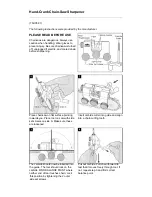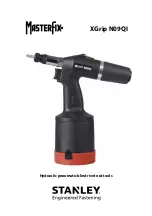
5
Inspect that the fastener has not damaged the insulation of
the electrical cables. A fastener that damages the insulation
of electric cables can lead to electric shock and fire hazards.
Do not use this tacker for fastening electrical cable. It
is not designed for electric cable installation and may
damage the insulation of electric cables thereby causing
electric shock of fire hazards.
TECHNICAL DATA
• Magazine capacity: 110 brad nails
• Nails, TJEP high penetration brads for electric nailers.
1x1.25
15(5/8)
30(1-3/16)
TJ
EP
TF
-1
8/
30
E
• Maximum drive speed: 3 pcs per second
• Maximum average fastener drive rate:
20 brad nails per minute.
• Nominal voltage: 220/240 V 50/60 HZ
• 10 A electric supply outlet
• 10-16 A line protection “slow blow”
• Noise level at 20 shots/min: LwA = 94 dB
• Vibrations at 20 shots/min.: < 4.9 m/s
2
• Cable extention lengths 10 m. (2x1.5 mm
2
)
max. m. 15 (2 x 2.5mm
2
)
• Trigger lock to prevent accidental fastener drive.
• Double insulated Class II
• Removable front plate without tools.
• Dimensions: 206 x 192 x 55 mm.
• Weight: 1,40 Kg. approx
LOADING
• Hold tool in left hand with feeder plate lever (A
fig. 1
) in
the right hand.
• Pull the feeder plate lever (A
fig. 2
) fully to the rear of
the magazine (see
fig. 2
).
• Turn the feeder plate lever (A
fig. 3
). The feeder plate
(B
fig.
3) will enter a recess in the magazine and remain
in that position.
•
WARNING:
Rotate the feeder plate lever (A) only to the
end of lever. Otherwise the mechanism will be damaged.
• Insert the brad nail strip (C
fig. 4
).
•
WARNING:
For all brad nail lengths, brad points
must rest on the lower guide of the magazine(E
fig. 4
),
otherwise the nailer will be damaged.
• Put the feeder plate lever (A) in line with the carriage (D
fig. 2
) and gently guide it to meet the brad nail strip (C)
already inserted.
•
WARNING:
never let the feeder plate lever (A) fly back.
The mechanism will be damaged.
OPERATION
• Insert the plug into the socket.
• Hold the nailer firmly against the surface to be nailed
(see
fig. 5
).
• To nail, push the safety lever (H) forwards until it is
recessed in the trigger (N) then press the trigger.
•
WARNING:
do not force the lever (H) backwards, or it
will break.
• Release the trigger completely after each fastener
drive.
• Do not operate it empty, in the air and on impenetrable
surfaces.
• Always unplug after use.
USE
• To nail finished surfaces without damaging them the nailer must
be placed on the base (I
fig. 5
) so that the front plate (M
fig. 5
) does
not touch the finished surface.
• On very hard woods, hold the nailer tightly with both hands
and tilted forwards as in
fig. 6
.
• The tool can be held in the inverted position, as in fig. 11 and
drive nails in all positions as in
figures 8, 9, 10 and 11
.
• To conceal the brad heads, nail into the notches of narrow
profiles as in
fig. 8
.
• Profile boards may be fixed without using panelling clips by
driving nails into stilts, as in
fig. 8 and 10
.
UNJAMMING
• The removable front plate (M
fig. 7
) usually stops
jamming occurring, Should jamming occur, do not
operate the tool.
• Remove the plug
• Position the feeder plate lever (A as in
fig. 3
), If
possible remove the brads from the back
• Turn the front plate retainer (O as in
fig. 7
) upwards
and slide the front plate (M
Fig. 7
) downwards.
• Slide the feeder plate (B
fig. 3
) forward slowly and
remove the jammed nail brads from the front of the tool.
• Do not use screwdrivers or other tools to remove the brads.
• Replace the front plate and check, before operating,
that brads are those required and are not defective.
• If the defect persists, contact the Service Department
and in case of return of the tool also used brads must be
sent back.
MAINTENANCE
(fig. 12)
• Unplug and unload the magazine.
• Remove and clean the front plate (M).
• Clean the brad strip channel (P) with a jet of compressed
air, in particular on the front of the wheel (Q) of the spring
and along the spring.
• Lubricate the driver slide area (S, T) and the wheel pins
(Q) with a drop of mineral oil.
• Clean the outside with a damp cloth. Never use solvents
or other liquids in the cleaning operations.
• Do not lubricate the internal parts of the brad nailer.
• Replace the front plate (M) and test the tool.
REPAIRS
• Do not disassemble or alter the tool.
All repairs must be
performed by specialised personnel only.
• When requesting technical or commercial assistance,
give the model, voltage and series of used brads.
Содержание TJEP TF-18/30 E
Страница 1: ...1 www tjep eu TJEP TF 18 30 E ...
Страница 22: ...22 TJEP TF 18 30 E electric GR 1x1 25 15 5 8 30 1 3 16 TJEP TF 18 30 E ...
Страница 23: ...23 ...
Страница 25: ...25 Fig 1 Fig 3 Fig 5 Fig 8 Fig 10 Fig 9 Fig 11 Fig 6 Fig 2 Fig 4 Fig 7 Fig 12 ...
Страница 32: ...32 TJEP TF 18 30 E ...
Страница 33: ...33 ...






































